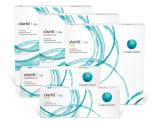Comparison of axial elongation among emmetropes, untreated progressing myopes, and treated myopes places treatment efficacy in the context of normal childhood eye growth
SAN RAMON, Calif., May 12, 2021—A new paper that has been accepted for publication in Ophthalmic & Physiological Optics, the peer-reviewed journal of The College of Optometrists (UK), furthers understanding of myopia control efficacy in the context of normal childhood eye growth. Axial Length Targets for Myopia Control (Chamberlain P, et al.) is now available online via Open Access.
Since young eyes grow, even when not myopic, the paper compares axial elongation among children who remain emmetropic, children with untreated myopia progression, and children with myopia managed with CooperVision MiSight® 1 day myopia control lenses. The comparison uses data from the three-year MiSight® 1 day clinical study, the Orinda Longitudinal Study of Myopia (OLSM)1 and the Singapore Cohort Study of the Risk Factors for Myopia (SCORM).2
The analysis revealed that the predicted three-year axial elongation for emmetropic children (0.24 mm) is similar to the mean three-year elongation in MiSight® 1 day-treated children with myopia (0.30 mm).3,4 In contrast, the axial elongation (0.63 mm) observed in the control group in the MiSight® 1 day clinical study was much higher, and similar to virtual cohorts based on the OLSM (0.70 mm) and SCORM (0.65 mm) models for myopia development.3,4
This observation suggests that while abnormal myopic eye growth may be managed with MiSight® 1 day in age-appropriate children, normal, physiological eye growth may continue as the child ages. It supports the hypothesis that myopic axial elongation may be superimposed on underlying physiological axial elongation.
“Some eye growth as part of the aging process is normal—myopic axial elongation is not. Our work further validates that evidence-based interventions can be highly effective in slowing that myopic eye growth,” said Paul Chamberlain, BSc (Hons), MCOptom, the paper’s lead author and Director of Research Programs for CooperVision. “This offers hope to healthcare systems, currently bearing the growing burden of visual impairment linked to the increasing prevalence and severity of myopia.”
MiSight® 1 day contact lenses designed for myopia control have been shown to reduce the rate of axial elongation in age-appropriate children by 52% on average over a three-year period.†4 As measured by spherical refraction, the lens reduced the rate of myopia progression in age-appropriate children by 59% on average over the same period.†4
“In assessing treatment effectiveness, we caution our industry away from applying arbitrary correction factors to account for normal, physiological eye growth until this has been better understood. Efficacy percentages may seem higher presented in that light, but it complicates understanding and valid comparisons,” said co-author Mark Bullimore, MCOptom, PhD, FAAO. “Eye care professionals must be able to rely on the ever-growing body of myopia literature to make evidence-based clinical decisions.”
# # #
Canadian Indications for Use: MiSight (omafilcon A) Soft Contact Lenses for Myopia Control may reduce the rate of myopia progression in children (6-18) and correct ametropia. Reduction of myopia progression was observed in children with wearing time of 12 hours (8-16 hours) per day, 6.4 days (5-7) per week in a clinical study. Permanent myopia control after lens treatment is discontinued is not supported by clinical studies. MiSight (omafilcon A) Soft Contact Lenses for Myopia Control are indicated for single use daily disposable wear. When prescribed for daily disposable wear, the lens is to be discarded after each removal.
About CooperVision
CooperVision, a division of CooperCompanies (NYSE:COO), is one of the world’s leading manufacturers of contact lenses. The company produces a full array of daily disposable, two-week and monthly soft contact lenses that feature advanced materials and optics, and premium rigid gas permeable lenses for orthokeratology and scleral designs. CooperVision has a strong heritage of addressing the toughest vision challenges such as astigmatism, presbyopia, childhood myopia, and highly irregular corneas; and offers the most complete portfolio of spherical, toric and multifocal products available. Through a combination of innovative products and focused practitioner support, the company brings a refreshing perspective to the marketplace, creating real advantages for customers and wearers. For more information, visit www.coopervision.com.
About CooperCompanies
CooperCompanies ("Cooper") is a global medical device company publicly traded on the NYSE (NYSE:COO). Cooper operates through two business units, CooperVision and CooperSurgical. CooperVision brings a refreshing perspective on vision care with a commitment to developing a wide range of high-quality products for contact lens wearers and providing focused practitioner support. CooperSurgical is committed to advancing the health of women, babies and families with its diversified portfolio of products and services focusing on medical devices and fertility & genomics. Headquartered in San Ramon, Calif., Cooper has a workforce of more than 12,000 with products sold in over 100 countries. For more information, please visit www.coopercos.com.
Media Contact
Hannah Barry, Associate Counselor, McDougall Communications
hannah@mcdougallpr.com or +1 (585) 645-8985
† Compared to a single vision 1 day lens.
1. Zadnik K, Mutti DO, Friedman NE & Adams AJ. Initial cross-sectional results from the Orinda longitudinal study of myopia. Optom Vis Sci 1993; 70: 750–758.
2. Saw SM, Tong L, Chua WH et al. Incidence and progression of myopia in Singaporean school children. Invest Ophthalmol Vis Sci 2005; 46: 51–57
3. Chamberlain P, Lazon de la Jara P, Arumugam B, & Bullimore MA. Axial length targets for myopia control. Ophthalmic Physiol Opt. 2021. https://doi.org/10.1111/opo.12812
4. Chamberlain P, et al. A 3-year randomized clinical trial of MiSight® lenses for myopia control. Optom Vis Sci. (2019); 96(8):556-567. Compared to a single vision 1 day lens over a 3 year period.






